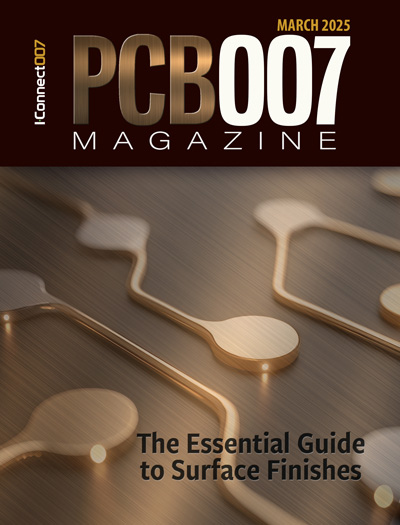-

- News
- Books
Featured Books
- pcb007 Magazine
Latest Issues
Current Issue
In Pursuit of Perfection: Defect Reduction
For bare PCB board fabrication, defect reduction is a critical aspect of a company's bottom line profitability. In this issue, we examine how imaging, etching, and plating processes can provide information and insight into reducing defects and increasing yields.

Voices of the Industry
We take the pulse of the PCB industry by sharing insights from leading fabricators and suppliers in this month's issue. We've gathered their thoughts on the new U.S. administration, spending, the war in Ukraine, and their most pressing needs. It’s an eye-opening and enlightening look behind the curtain.

The Essential Guide to Surface Finishes
We go back to basics this month with a recount of a little history, and look forward to addressing the many challenges that high density, high frequency, adhesion, SI, and corrosion concerns for harsh environments bring to the fore. We compare and contrast surface finishes by type and application, take a hard look at the many iterations of gold plating, and address palladium as a surface finish.
- Articles
- Columns
Search Console
- Links
- Media kit
||| MENU - pcb007 Magazine
Patty's Perspective: Are We Flying Yet?
September 12, 2016 | Patty Goldman, I-Connect007Estimated reading time: 2 minutes
Walt Custer is on a photo safari in Africa and suggested I take a look at some of his slides regarding the military/aerospace market and then give a little report on it. Well, I am no Walt Custer, so while I can tell you a bit about where things are, far be it from me to make predictions.
In 2015, the military market represented 8.4% of the world market for electronic equipment production. As a comparison, the communication and automotive markets were 22.2% and 8.6%, respectively. Monthly defense equipment orders have been between $3–3.5B for 2015, rising slightly in 2016, while inventories have remained stable at around $6 billion. For 2015, worldwide production of military and aerospace PCBs was 5.1% of the total $59.2 billion market. Note that all of these numbers and percentages are in dollars, which no doubt means the total percent of square footage produced for the mil/aero industry was considerably lower. See the charts on the next page.
Aircraft deliveries have seen a steady rise; predictions are for a slow, steady rise from approximately 1430 units in 2016 to approximately 1750 by 2032. In the aircraft end of things, non-military represents roughly two-thirds of the shipments (including parts).
According to Walt (and others, of course) the best opportunities for North American and European PCB manufacturers are military, security and medical electronics; PCBs with intellectual property/sensitive content issues; quick-turn, prototype and novel PCBs; and those requiring close collaboration and local support. Most everyone has figured out the need for a high mix/ low volume operation and often look to global (read Asia) partnerships for high-volume work.
We all know that building for the military and aerospace industries is not for the faint of heart, nor for those lacking persistence and/or looking for the quick project or sale. We hope that our authors and columnists below provide some additional insight on this important market and what is required to participate.
First up, John Vaughan (Zentech Manufacturing) fills us in on recent market developments that should be of particular interest to both PCB and EMS manufacturers. He covers the F-35 and F-16 programs in detail, then discusses foreign military sales (FMS) and efforts to speed up the approval process.
Next, Dan Feinberg (Feinline Associates) explores disruptive technologies, in particular virtual and augmented reality. While we often think of VR/AR as sophisticated toys, in reality many applications are already in use involving the mil/aero industry, including training, treatment and more—a lot more.
Regular columnist Dave Becker (All Flex Flexible Circuits) discusses mil/aero specifications from the flex circuit manufacturer’s point of view. He first gives us a little history on flex specs including Mil-P-50884, Mil-PRF-31032 and IPC 6013, explaining the differences along the way. Omni PCB’s Tara Dunn, in her column, complements this nicely with a discussion on troubleshooting some mil/aero flex projects.
Editor's Note: This column originally appeared in the September 2016 issue of The PCB Magazine.
Suggested Items
Merlin Circuit Technology Earns NADCAP 2nd Year Merit
05/13/2025 | Merlin Circuit TechnologyMerlin Circuit Technology Ltd, a leading manufacturer of advanced printed circuit boards (PCBs) for mission-critical applications, has announced the successful completion of its latest NADCAP audit, achieving prestigious 2nd Year Merit Status.
Vertical Aerospace, Honeywell Expand Partnership to Bring VX4 eVTOL to Market
05/13/2025 | HoneywellVertical Aerospace and Honeywell announced the signing of a new long-term agreement that expands their existing partnership and reinforces Honeywell’s commitment to the certification and production of Vertical’s electric vertical take-off and landing (eVTOL) aircraft, the VX4.
Barnes Aerospace Appoints George Whittier as CEO
05/12/2025 | BUSINESS WIREBarnes Aerospace, a global provider of component repair services and manufacturer of highly-engineered parts primarily for aeroengines and an operating division of Barnes Group Inc., announced the appointment of George Whittier to the newly created role of CEO, effective May 12, 2025.
'Chill Out' with TopLine’s President Martin Hart to Discuss Cold Electronics at SPWG 2025
05/02/2025 | TopLineBraided Solder Columns can withstand the rigors of deep space cold and cryogenic environments, and represent a robust new solution to challenges facing next generation large packages in electronics assembly.
Kitron: Q1 2025 - Strong Start to the Year
04/25/2025 | KitronKitron reported first-quarter results characterised by continued momentum in the Defence & Aerospace market sector and a growing order backlog.


